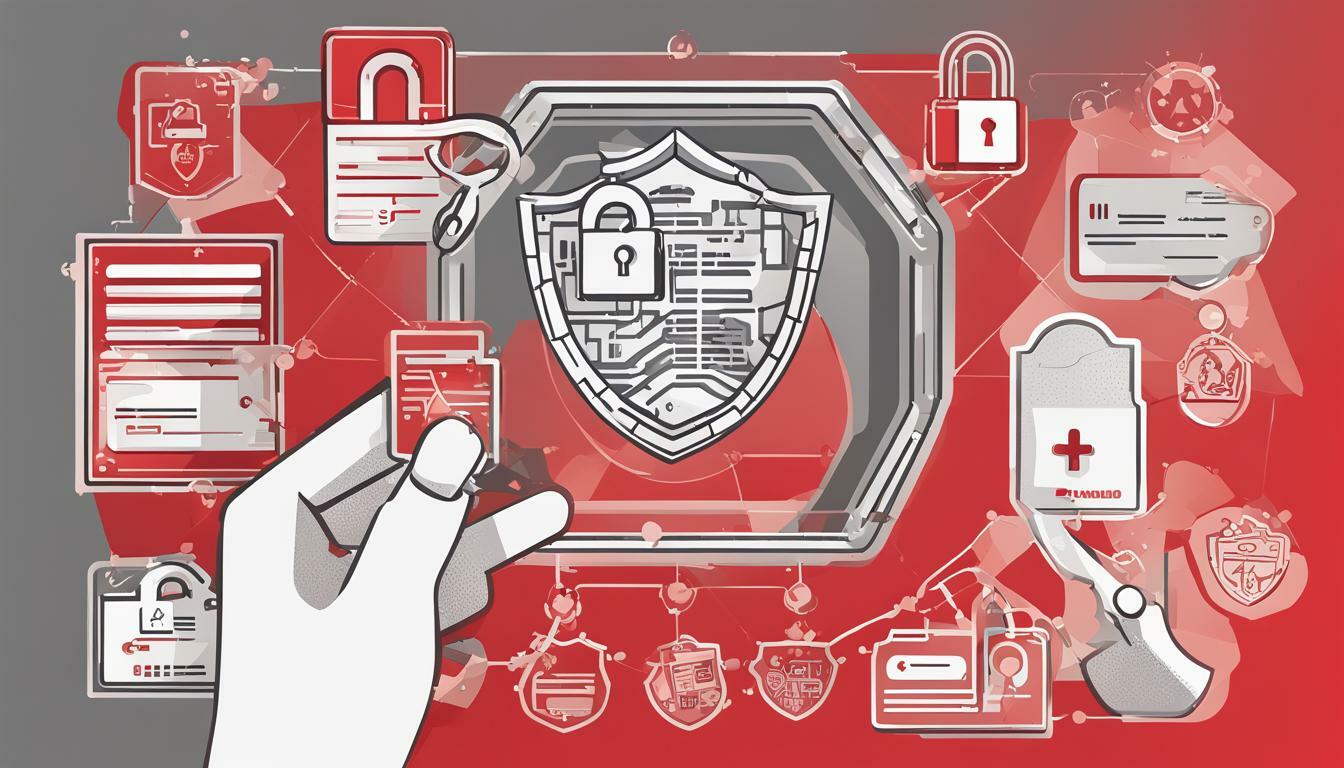
In today’s digital age, identity theft has become a growing concern for individuals and businesses alike. With the widespread use of technology for storing personal and sensitive data, it has become easier for cybercriminals to gain unauthorized access to this information. This is where implementing security measures in authentication systems is crucial for preventing identity theft.
Authentication systems refer to the methods used to verify and grant access to digital information, such as usernames and passwords. Security measures are the additional layers of protection added to these systems to ensure that only authorized parties can gain access.
Key Takeaways:
- Identity theft is a growing concern in the digital age
- Authentication systems are used to verify and grant access to digital information
- Security measures are essential for preventing unauthorized access and identity theft
Understanding Identity Theft
Identity theft is a form of fraud in which an individual’s personal information is stolen by someone else with the intent of committing fraudulent activities. Identity theft is a serious crime that can have devastating consequences for victims, including financial loss and damage to their credit score.
Identity theft prevention involves taking proactive measures to protect personal information from falling into the wrong hands. Identity theft protection involves monitoring credit reports and financial statements for suspicious activity. Identity theft security involves implementing security measures to prevent unauthorized access to personal information.
It’s important to be aware of the potential risks of identity theft and take steps to protect yourself and your personal information. Keep reading to learn more about the different types of authentication systems and security measures that can help prevent identity theft.
Types of Authentication Systems
Authentication systems are utilized for verifying and granting access to digital information. There are different types of authentication systems available, each with their own unique features and benefits. Understanding the various authentication systems can help individuals and businesses choose the best options for their particular needs.
| Authentication System Type | Description |
|---|---|
| Password-Based Authentication | This is a common authentication method where users enter a unique combination of characters, known as passwords, to verify their identity. |
| Token-Based Authentication | With this type of authentication, users are provided with a physical or virtual token, such as a key fob or smart card, to access a system. These tokens generate a unique code that changes frequently and must be used in conjunction with a password. |
| Biometric Authentication | This system relies on unique biological traits, such as fingerprint or retina scans, to verify a user’s identity. Biometric authentication is considered to be a highly secure form of authentication. |
| Multi-Factor Authentication | This method requires users to provide two or more forms of authentication to verify their identity, such as a password and a fingerprint scan. Multi-factor authentication is a very effective way to prevent unauthorized access. |
Authentication security is an important consideration for individuals and businesses alike. Choosing the most appropriate authentication system can help to prevent data breaches and identity theft, safeguarding sensitive information and assets.
Common Security Measures
Identity theft is a serious threat that can cause considerable financial and personal damage to individuals and businesses. Implementing security measures is crucial in preventing identity theft and mitigating its impact. Here are some common security measures that can help safeguard your identity:
| Security Measures | Description |
|---|---|
| Strong Passwords | Use a mix of upper and lowercase letters, numbers, and symbols. Avoid using easily guessable information such as your name, birthdate, or common words. |
| Multi-Factor Authentication | Add an extra layer of security by requiring a second form of verification, such as a fingerprint scan or a security code sent to your phone. |
| Encryption | Use encryption software to protect sensitive information such as financial data, health records, or personal identification information (PII). |
| Update Software | Install updates and security patches regularly to ensure your operating system, applications, and antivirus software are up to date. |
By applying these security measures, you can significantly reduce your risk of identity theft. However, it’s essential to remain vigilant and stay informed about new threats and emerging trends in identity theft. Don’t assume that you are immune to identity theft and don’t let your guard down. Be proactive in protecting your identity and your personal information.
Biometric Authentication
As technology advances, so do the methods for authentication security. Biometric authentication is a relatively new and highly secure way of identifying individuals based on their unique physical characteristics. This form of authentication uses biometric sensors to detect and analyze specific physical traits, such as fingerprints, iris patterns, and facial features, to grant access to digital information.
Biometric authentication is considered to be more secure than traditional methods of authentication, such as passwords or PINs, as it is virtually impossible to replicate someone’s biometric data. However, it is important to note that biometric data can still be vulnerable to hacking or theft if it is not properly protected.
Protecting Personal Information
In today’s digital age, protecting personal information is more crucial than ever. Individuals need to take proactive steps to safeguard their sensitive data to prevent identity theft and financial loss. Here are some practical tips and strategies to ensure identity protection measures are in place:
- Use Strong Passwords: A strong password is the first line of defense against cyber-attacks. It should be unique and comprise a combination of upper and lower case letters, numbers, and special characters. Passwords should also be changed regularly to reduce the risk of hacking.
- Enable Multi-Factor Authentication: Multi-factor authentication adds an extra layer of security to prevent unauthorized access. This feature requires individuals to provide two or more forms of identification, such as a password and a fingerprint or facial recognition scan.
- Encrypt sensitive data: Encryption is a method of converting plain text into a secret code to protect data from unauthorized access. Individuals should encrypt sensitive data, such as financial information, stored on devices and in cloud-based storage solutions.
- Use a VPN: A virtual private network (VPN) encrypts internet traffic, making it more challenging for hackers to intercept data. Individuals should use a VPN when accessing the internet in public places, such as coffee shops and airports.
- Avoid Phishing Scams: Phishing scams are fraudulent emails or texts that trick individuals into providing sensitive information. Individuals should never click on suspicious links or respond to unsolicited emails requesting personal data.
- Keep Software up to Date: Software vulnerabilities can be exploited by hackers to gain access to sensitive data. Individuals should regularly update their operating systems, antivirus software, and other applications to ensure they have the latest security patches and bug fixes.
- Be Careful with Social Media: Social media platforms are a potential gold mine for cyber-criminals. Individuals should limit the personal information they share on social media and adjust privacy settings to limit access.
By implementing these identity protection measures, individuals can reduce the risk of identity theft and financial loss. However, it’s essential to remain vigilant and stay informed about evolving cybersecurity threats.
Conclusion
In conclusion, preventing identity theft is crucial in today’s digital age. Security measures in authentication systems play a significant role in ensuring the safety of personal information. It is essential to understand the potential risks that identity theft poses to individuals and businesses. Therefore, implementing security measures such as strong passwords, multi-factor authentication, encryption, and biometric authentication can help prevent identity theft.
While these security measures are helpful, protecting personal information remains the responsibility of individuals. Practicing simple measures like avoiding sharing personal information, being careful with emails and texts, verifying the authenticity of websites before sharing information, and checking bank statements regularly can go a long way in protecting against identity theft.
Overall, implementing security measures in authentication systems and taking proactive steps to prevent identity theft is critical. Awareness and ongoing vigilance about personal information protection are essential to ensure our safety in the digital world.
FAQ
Q: What is identity theft?
A: Identity theft refers to the unauthorized acquisition and usage of someone’s personal information, such as their name, social security number, or financial details, for fraudulent purposes.
Q: What are the potential risks of identity theft?
A: Identity theft can lead to financial loss, damage to one’s credit score, and emotional distress. It can also result in the misuse of personal information and the potential for criminal activities to be carried out in the victim’s name.
Q: What are authentication systems?
A: Authentication systems are mechanisms used to verify the identity of individuals seeking access to digital information. They ensure that only authorized users can gain entry to protected resources.
Q: What are some common security measures to prevent identity theft?
A: Common security measures include using strong and unique passwords, enabling multi-factor authentication, regularly updating software and applications, and employing data encryption techniques.
Q: What is biometric authentication?
A: Biometric authentication utilizes unique physical or behavioral characteristics, such as fingerprints or facial recognition, to verify an individual’s identity. It provides a higher level of security compared to traditional authentication methods.
Q: How can I protect my personal information?
A: To protect your personal information, you should be cautious when sharing it online, use secure Wi-Fi networks, regularly monitor your financial accounts, and shred or securely dispose of sensitive documents.
Q: Why is implementing security measures in authentication systems important?
A: Implementing security measures in authentication systems is crucial to prevent identity theft. By incorporating strong authentication protocols and encryption techniques, you can significantly reduce the risk of unauthorized access to sensitive information.








